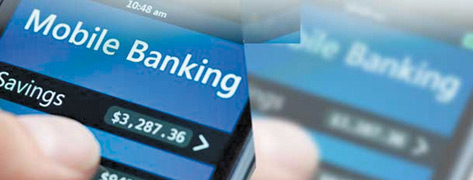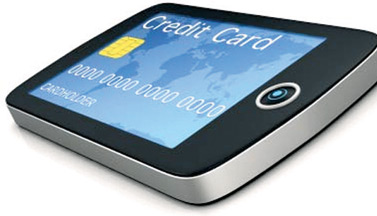Electronic payment systems for financial inclusion
By Gamini Warushamana
 In a barter economy where there was no medium of transaction, trade
and transactions were based on the exchange of goods and services. As a
result of the difficulty in exchanging goods and services with the
economy and society becoming more complex, money came as an intermediary
in trade and at the early stage anything that could symbolise some value
such as shells or pieces of metal was used as money. In a barter economy where there was no medium of transaction, trade
and transactions were based on the exchange of goods and services. As a
result of the difficulty in exchanging goods and services with the
economy and society becoming more complex, money came as an intermediary
in trade and at the early stage anything that could symbolise some value
such as shells or pieces of metal was used as money.
The history of money in Sri Lanka goes back to the Anuradhapura
Kingdom from the third century BC and the first coin used in Sri Lanka
is referred to as a Kahapana.
Kahapanas were in metal form with embedded symbols. Thereafter, a
gradual evolution of money could be seen and there is historical
evidence in the use of foreign coins such as Roman coins in four CE.
In the colonial era various notes and coins had been introduced under
three colonial rulers and finally came the Rupee.
Notes and coins
This long history of local currency has now come to a crucial point
because we are now entering a cashless society where money is replaced
by electronic fund transfer methods, that anything physical, such as
notes and coins, are not necessary, said Senior Manager, Business
Development and Brand Promotions at Lanka Clear (LC), Chris de Alwis.
Money plays many important roles in an economy, such as medium of
exchange, unit of account, store and measure of value, and standard of
differed payments.
With the electronic payment system, the role of notes and coins (the
medium of exchange) is diminishing. This new era dawned with the advent
of computers and electronic communications. A large number of
alternative electronic payment systems have emerged on top of this
computer and communication infrastructure, such as debit and credit
cards, internet banking, mobile payments and e-commerce payment systems.
Expansion of non-cash transactions is a global scenario and the
growth is faster in some emerging and developing economies.
According to the World Payments Report 2013 of the Royal Bank of
Scotland, global non-cash transactions accelerated during 2011 and
developing economies fuelled the rise. According to the report volumes
grew 8.8% during the year to reach 307 billion transactions.
There are many advantages in electronic transaction systems. It
reduces transaction cost and attracts money that is idling not giving
any interest to the owner or any value to the economy in the formal
financial system.
Cheques are the first alternative to cash and the setting up of Lanka
Clear in 2002 was a milestone in electronic fund transferring in Sri
Lanka, Alwis said.
LC was started as the infrastructure provider to the banking and
finance sector and introduced two flagship products, cheque clearance
and the Sri Lanka Inter Bank Payment System (SLIPS). Both products
evolved over time and cheque clearance which took several days earlier
became a one-day operation, being the first in the region and the second
in the world.
SLIPS too became a one-day operation and it was also the first
one-day fund transfer system in the region. Therefore, Sri Lanka is in
the forefront in introducing innovative electronic payment systems.
With these products people can transfer funds through 35 SLIPS
partners, banks and finance companies, using over 3,000 branch networks
islandwide. The target of LC is to develop this system to a real time
fund transferring system, Alwis said.
In 2012, LC transformed itself from a national cheque clearance house
to a national payment infrastructure provider by introducing Lanka Pay
payment network. Through this network, LC facilitates all the electronic
payments in domestic transactions.
 "There are several advantages in this kind of local network. Today,
we use foreign payment networks, Visa and Master Card for all electronic
payments, domestic and foreign. "There are several advantages in this kind of local network. Today,
we use foreign payment networks, Visa and Master Card for all electronic
payments, domestic and foreign.
Lanka Pay
According to Central Bank statistics there are over one million
credit cards and 10 million debit cards in use in Sri Lanka and over 90
percent of the transactions are local," Alwis said.
"We have to pay charges for each transaction for which the rates are
not transparent and it drains out foreign exchange. Paying foreign
networks for domestic transactions is a waste of foreign exchange.
Therefore, the solution is to introduce a national card scheme and LC
has now introduced a new card with the Lanka Pay mark," he said.
"Financial inclusion is another aspect of this payment network and we
believe that this technology and the convenience of financial
transactions should go to the masses," Alwis said.
Every Sri Lankan has the right to access the latest payment
technology. Common payment system will also open a lot of opportunities.
"We need cards (debit and credit cards) that open at every Point of
Sales (POS) terminal and ATM machine. This kind of integrated payment
network will give seamless transaction opportunities to the people," he
said.
To create a national payment network with interoperability, LC has
now launched a common ATM service, Lanka Pay Common ATM switch.
Hurdle
"Here we link the existing ATM infrastructure within the country.
Today, we have five banks - Bank of Ceylon, People's Bank, HNB, Seylan
and Union Bank in this network. With these banks, LC has reached over
1,600 ATMs islandwide. Soon another three banks will join us and our ATM
network will expand to over 2,000 ATMs and we will reach two-thirds of
the 3,000 ATMs in the country," Alwis said.
This means the ATMs in the Lanka Pay network can handle multiple
cards issued by various banks. Even today, banks have mutual
arrangements to share their ATMs, but this common network will connect
all the ATMs in the country.
This common network will also slash exorbitant charges by the banks
for sharing their infrastructure which is a hurdle in the promotion of
electronic payments.
To reduce transaction costs the Central Bank (CB) has now introduced
a cap of Rs. 30 per transaction. The banks too have advantages and they
need not invest and maintain ATMs and they can concentrate on their core
business. An efficient electronic payment system will facilitate
efficient and secure transactions for a majority of the people.
Transaction costs should be reasonable. A payment network such as
this will boost trade and business. However, the present situation in
electronic payments in Sri Lanka is not satisfactory in all aspects.
Electronic payment is possible at selected places such as supermarkets
and only a privileged few have access to it.
Affordable
Exorbitant charges is another issue and in some transactions you have
to pay a 3% charge on top of your bill. In other cases it is higher than
the profit margin of some commodities. Under these circumstances
expansion of e-commerce is difficult because the connectivity to the
payment network and installation of POS terminal too is costly and not
affordable to all traders.
There are only around 25,000 POS machines in the country at present.
Therefore, there is a need to develop infrastructure and make POS
terminals at every retail outlet affordable. LC will introduce a common
POS service to address this issue and Alwis said that a national card
scheme and a common POS service should go hand-in-hand.
 The internet is another channel that enables electronic transactions
and the banking system and infrastructure should be ready to cater to
the demand created with increasing internet penetration. The internet is another channel that enables electronic transactions
and the banking system and infrastructure should be ready to cater to
the demand created with increasing internet penetration.
Internet penetration is around 30 percent at present and is
increasing rapidly.
The mobile phone is now emerging as a mode of electronic transactions
and fund transfer. This will remove most of the hurdles in popularising
electronic payments. Mobile phone penetration in Sri Lanka has now
reached over 20 million and virtually every citizen has a mobile phone.
As the infrastructure is ready and penetration is 100 percent, mobile
payment systems have the potential of becoming the best option. Several
mobile operators already provide mobile fund transfer services. Mobile
payment solutions have many advantages and it can be developed as a
means of extending financial services to the community that does not
have access to the banking system at all or has limited access.
These people are known as the 'unbanked' or 'under-banked'. According
to the Global Financial Development Report 2014 of the World Bank,
around 50 percent of the world's adult population are unbanked.
The report said that low-income populations benefit the most from
these technological innovations such as mobile payments, mobile banking
and borrower identification based on fingerprinting and iris scans. The
World Bank has set targets towards universal financial access for all
working-age adults by 2020.
The potential of mobile technology in improving financial inclusion
in developing countries and has already been proved and according to the
report, mobile banking has played a key role in expanding financial
services in low-income countries, such as Kenya, the Philippines, Brazil
and Tanzania.
According to the Electronic Transactions Association (ETA) people in
Kenya transact business using M-pesa, a mobile platform via text
messages and monthly transactions are equivalent to US$ 822 million. |

